AUDI A8 2011 Owners Manual
Manufacturer: AUDI, Model Year: 2011, Model line: A8, Model: AUDI A8 2011Pages: 302, PDF Size: 76.07 MB
Page 141 of 302
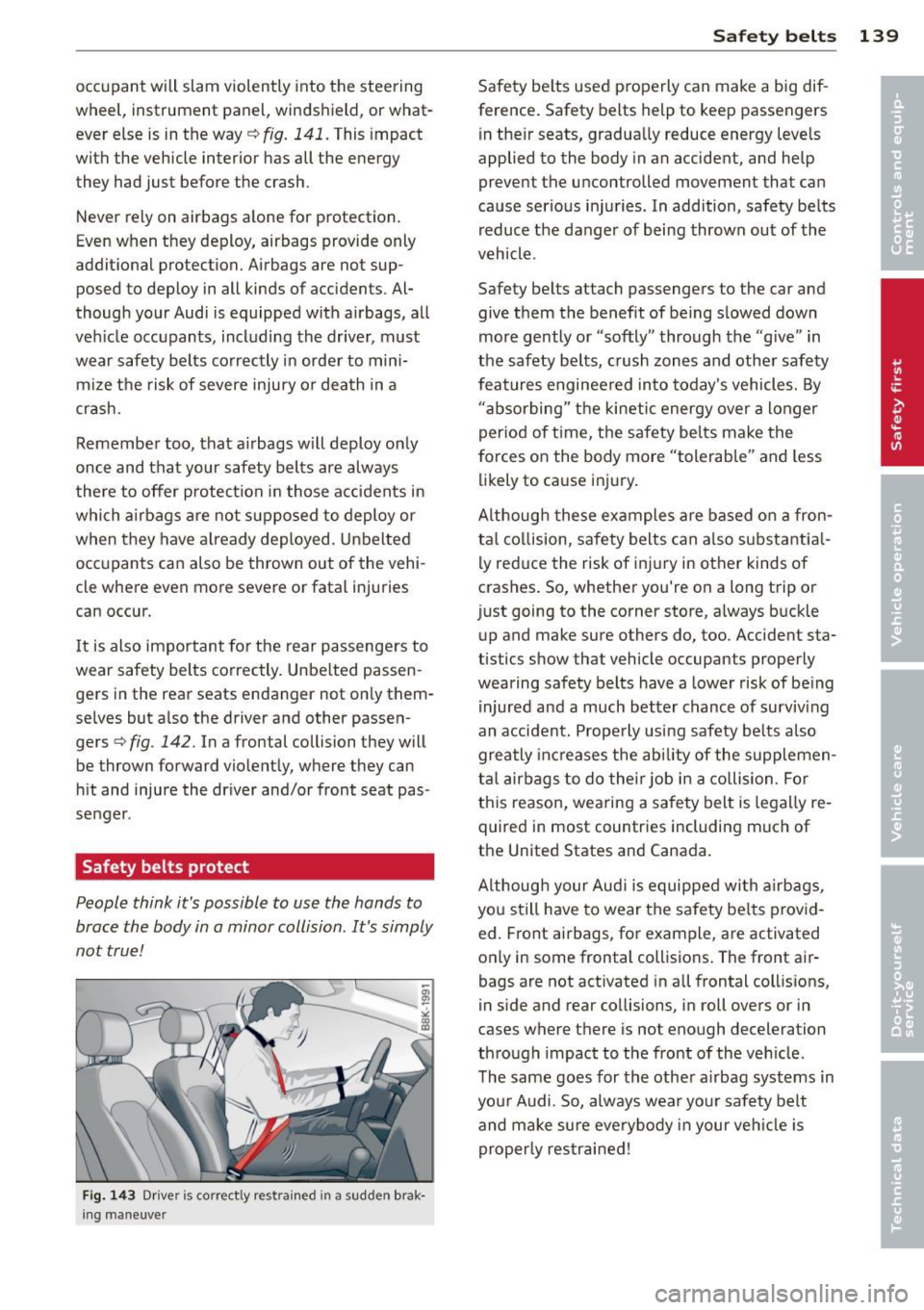
occupant will slam violently into the steering
wheel, instrument panel, windshield , or what
ever else is in the way
c::> fig. 141. This impact
with the vehicle interior has all the energy
they had just before the crash.
Never rely on airbags alone for protection.
Even when they deploy, airbags provide only
additional protection. Airbags are not sup
posed to deploy in all kinds of accidents. Al
though your Audi is equipped with airbags, all
vehicle occupants, including the driver, must
wear safety belts correctly in order to mini
mize the risk of severe injury or death in a
crash.
Remember too, that airbags will deploy only
once and that your safety belts are always
there to offer protection in those accidents in
which airbags are not supposed to deploy or
when they have already deployed. Unbelted
occupants can also be thrown out of the vehi
cle where even more severe or fatal injuries
can occur.
It is also important for the rear passengers to
wear safety belts correctly. Unbelted passen
gers in the rear seats endanger not only them
selves but also the driver and other passen
gers
c::> fig. 142. In a frontal collision they will
be thrown forward violently, where they can
hit and injure the driver and/or front seat pas
senger.
Safety belts protect
People think it's possible to use the hands to
brace the body in a minor collision . It's simply
not true!
Fig. 143 Driver is correct ly res trained in a sudden brak
ing maneuve r
Safety belts 139
Safety belts used properly can make a big dif
ference. Safety belts help to keep passengers
in their seats, gradually reduce energy levels
applied to the body in an accident, and help
prevent the uncontrolled movement that can
cause serious injuries . In addition, safety belts
reduce the danger of being thrown out of the
vehicle .
Safety belts attach passengers to the car and
give them the benefit of being slowed down
more gently or "softly" through the "give" in
the safety belts, crush zones and other safety
features engineered into today's vehicles. By
"absorbing" the kinetic energy over a longer
period of time, the safety belts make the
forces on the body more "tolerable" and less
likely to cause injury.
Although these examples are based on a fron
tal collision, safety belts can also su bsta ntia l
ly reduce the risk of injury in other kinds of
crashes. So, whether you're on a long trip or
just going to the corner store, always buckle
up and make sure others do, too. Accident sta
tistics show that vehicle occupants properly
wearing safety belts have a lower risk of being
injured and a much better chance of surviving
an accident. Properly using safety belts also
greatly increases the ability of the supplemen
tal airbags to do their job in a collision . For
this reason, wearing a safety belt is legally re
quired in most countries including much of
the United States and Canada.
Although your Audi is equipped with airbags,
you still have to wear the safety belts provid
ed. Front airbags, for example, are activated
only in some frontal collisions. The front air
bags are not activated in all frontal collisions,
in side and rear collisions, in roll overs or in
cases where there is not enough deceleration
through impact to the front of the vehicle.
The same goes for the other airbag systems in
your Audi. So, always wear your safety belt
and make sure everybody in your vehicle is
properly restrained!
Page 142 of 302
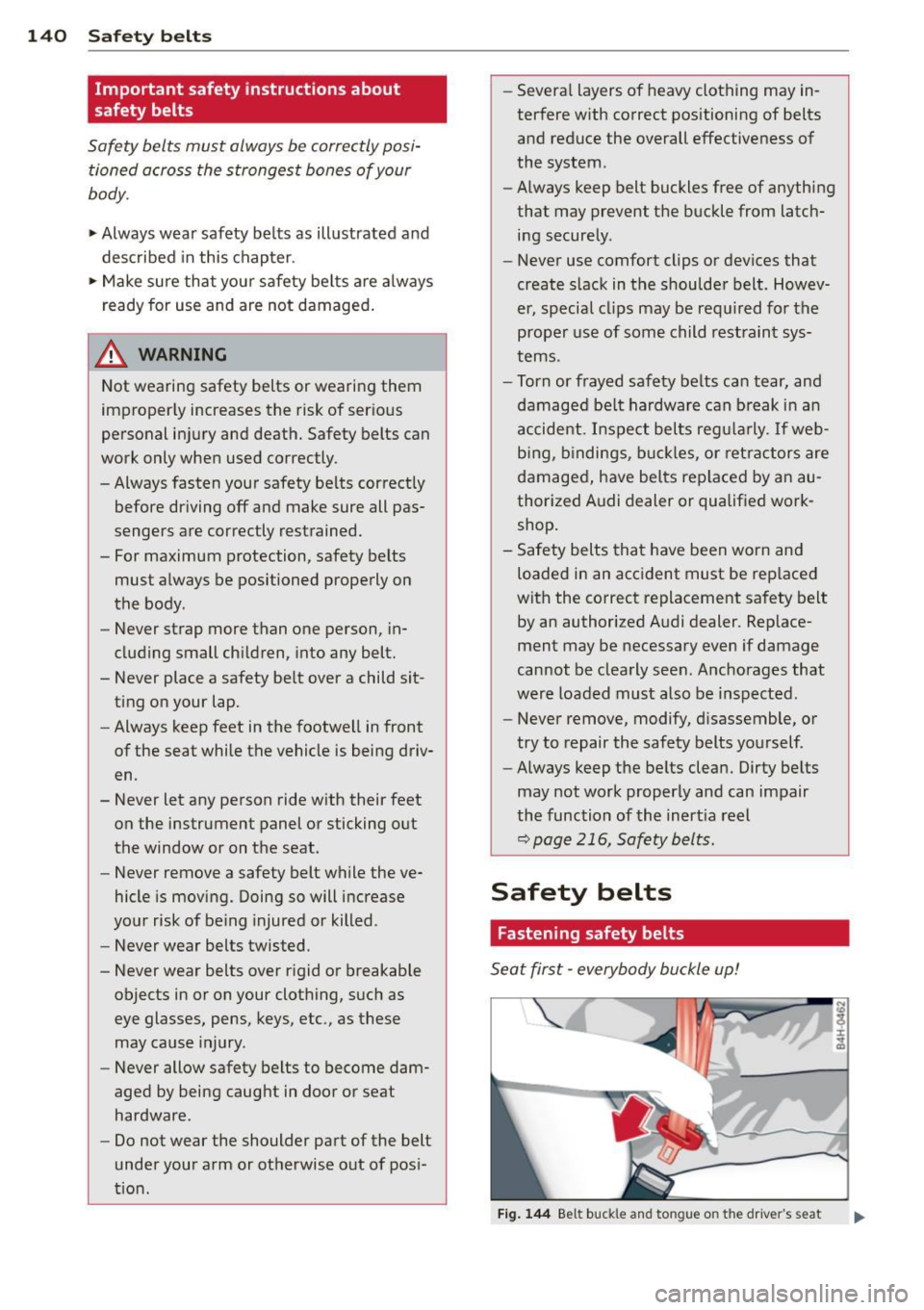
140 Safety belts
Important safety instructions about
safety belts
Safety belts must always be correctly posi
tioned across the strongest bones of your
body.
,.. Always wear safety belts as illustrated and
described in this chapter.
,.. Make sure that your safety belts are always
ready for use and are not damaged.
A WARNING
Not wearing safety belts or wearing them
improperly increases the risk of serious
personal injury and death. Safety belts can
work only when used correctly .
- Always fasten your safety belts correctly
before driving
off and make sure all pas
sengers are correctly restrained.
- For maximum protection, safety belts must always be positioned properly on
the body .
- Never strap more than one person , in
cluding small children, into any belt.
- Never place a safety belt over a child sit ting on your lap.
- Always keep feet in the footwell in front
of the seat while the vehicle is being driv
en .
- Never let any person ride with their feet on the instrument panel or sticking out
the window or on the seat .
- Never remove a safety belt while the ve
hicle is moving. Doing so will increase
your risk of be ing injured or killed.
- Never wear belts twisted.
- Never wear belts over rigid or breakable
objects in or on your clothing, such as
eye glasses, pens, keys, etc., as these
may cause injury.
- Never allow safety belts to become dam
aged by being caught in door or seat
hardware .
- Do not wear the shoulder pa rt of the belt
under your arm or otherwise out of pos i
tion . -
Several layers of heavy clothing may in
terfere with correct positioning of belts
and reduce the overall effectiveness of
the system .
- Always keep belt buckles free of anything
that may prevent the buckle from latch
ing securely .
- Never use comfort clips or devices that
create slack in the shoulder belt . Howev
er, special clips may be required for the
proper use of some child restraint sys
tems .
- Torn or frayed safety belts can tear, and
damaged belt hardware can break in an
accident. Inspect belts regularly .
If web
bing, bindings, buck les, or retractors are
damaged, have belts replaced by an au
thorized Audi dealer or qualified work
shop.
- Safety belts that have been worn and
loaded in an accident must be replaced
with the correct replacement safety belt
by an authorized Audi dealer . Replace
ment may be necessary even if damage
cannot be clearly seen . Anchorages that
were loaded must also be inspected.
- Never remove, modify, disassemble, or
try to repair the safety belts yourself.
- Always keep the belts clean. Dirty belts
may not work properly and can impair
the function of the inert ia reel
¢ page 216, Safety belts .
Safety belts
Fastening safety belts
Seat first -everybody buckle up!
Fig. 144 Be lt buck le and to ngue o n the drive r's se at
Page 143 of 302
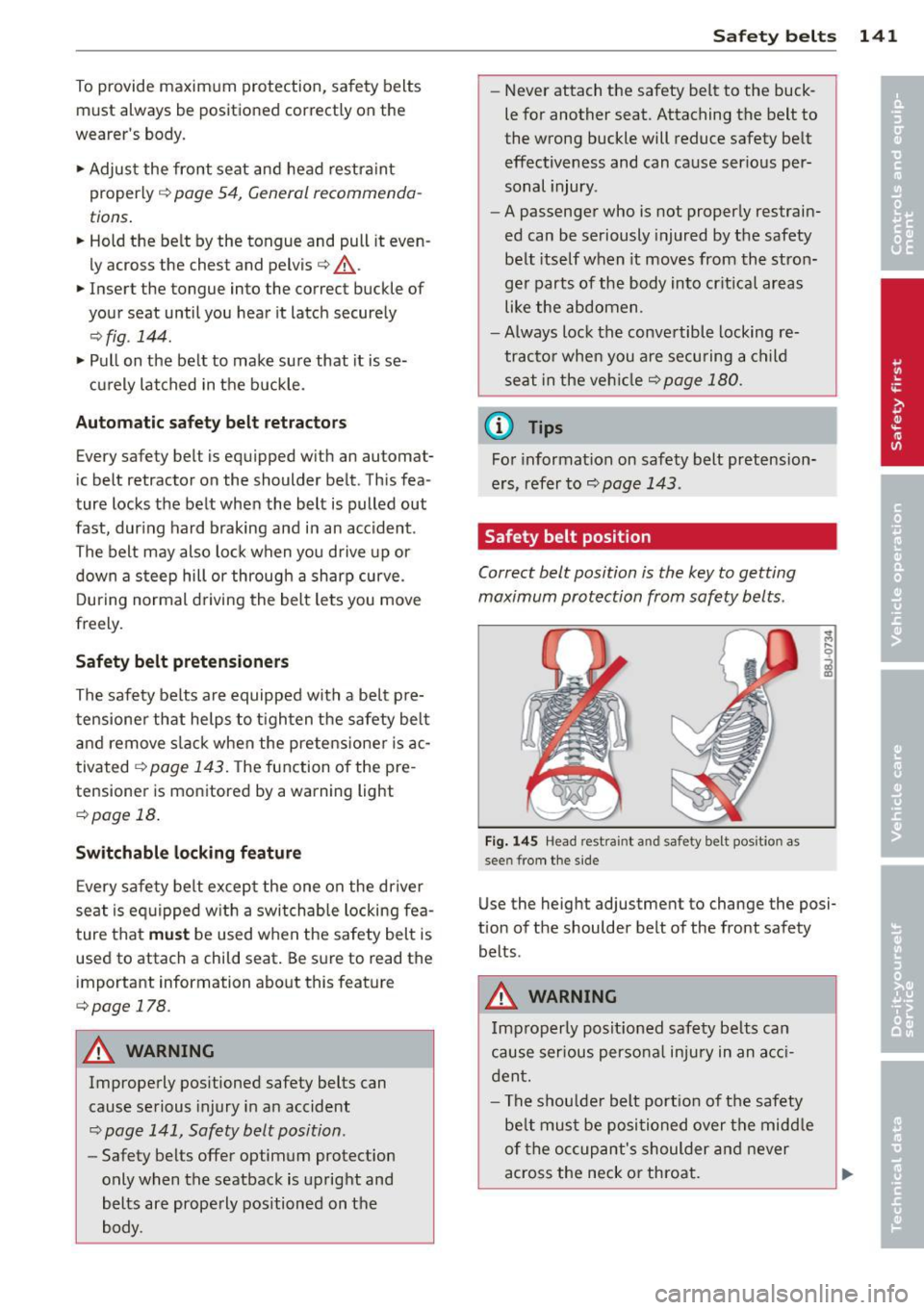
To provide maximum protection, safety belts
must always be positio ned cor rectly on the
wearer's body .
... Adjus t the front seat and head restraint
properly
c::> page 54, General recommenda
tions .
... Hold the be lt by the tongue and pull it even
ly across the chest and pelvis
c::> &,. .
""Insert the tongue into the correct buckle of
you r seat until you hear it latch securely
c::> fig. 144 .
""Pull on the belt to make su re that it is se-
c u rely latched in the buckle .
Automatic safety belt retractor s
Every safety belt is equipped with an automat
ic belt retractor on the shoulder belt. Th is fea
ture locks the belt when the belt is pulled out
fast, dur ing hard braking and in an accident .
The belt may also lo ck when you drive up or
down a steep hill or through a sharp curve .
During normal driving the belt le ts you
move
freely.
Safety belt pretensione rs
The safety belts are equipped with a belt p re
tensioner that helps to t igh ten the safety belt
and remove s lack when the pretensione r is ac
tivated
c::> page 143. The function of the pre
tensioner is monitored by a warning light
c::> page 18 .
Switchable locking f eature
Every safety belt except the one on the driver
seat is eq uipped w ith a switchable locking fea
ture that
mu st be used when the safety belt is
used to attach a child seat. Be sure to read the important information about this feature
c:;,page 178.
A WARNING
Improperly positioned safety belts can
cause serious injury in an accident
c::> page 141, Safety belt position .
-Safety belts offer optimum protection
only when the seatback is upright and
belts are properly positioned on the
body.
-
Safety belts 141
- Never attach the safety belt to the buck
le for another seat. Attaching the belt to
the wrong buckle will reduce safety belt
effectiveness and can cause serious per
sonal injury .
- A passenger who is not properly restrain
ed can be seriously injured by the safety
be lt itself when it
moves from the stron
ge r parts of the body into critical ar eas
like the abdomen.
- Always lock the convertible locking re
tracto r when you are secu ring a child
se at in the veh icle
c::>page 180.
@ Tips
For informat ion on safety belt pretension
e rs, refer to
c::> page 143 .
Safety belt position
Correct belt position is the key to getting
maximum protection from safety belts .
Fig. 14 S Head restra int and safety belt positio n as
see n from the side
Use the height adjustment to change the posi
t ion of the shoulder belt of the front safety
belts.
A WARNING
-Imp roperly posit ioned safety be lts can
cause ser ious perso na l inju ry in an a cc i
dent.
- The s hou lde r belt port io n of the safety
be lt must be posi tioned over the midd le
of the occupant's shoulder and never
across the neck or throat.
-
Page 144 of 302
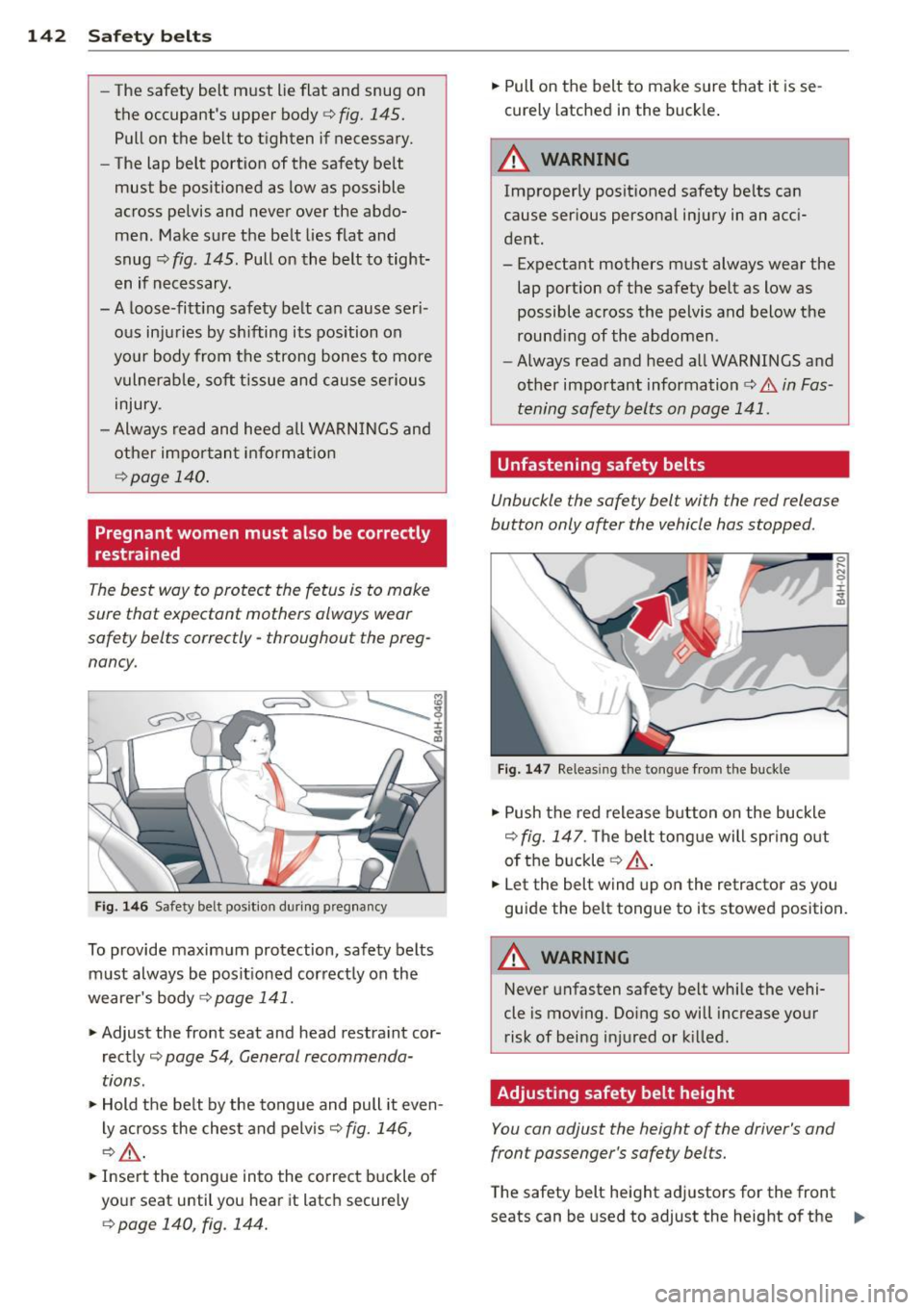
142 Safety belts
-The safety belt must lie flat and snug on
the occupant's upper body¢
fig. 145.
Pull on the belt to tighten if necessary.
- The lap belt portion of the safety belt
must be positioned as low as possible
across pelvis and never over the abdo
men . Make sure the belt lies flat and
snug ¢
fig. 145 . Pull on the belt to tight
en if necessary.
- A loose-fitting safety belt can cause seri
ous injuries by shifting its position on
your body from the strong bones to more
vulnerable, soft tissue and cause serious
injury .
- Always read and heed all WARNINGS and
other important information
¢ page 140.
Pregnant women must also be correctly
restrained
The best way to protect the fetus is to mak e
sure that expectant mothers always wear
saf ety belts correctly -throughout the preg
nancy .
Fig. 146 Safety be lt pos it ion during p regnancy
To provide maximum protection, safety belts
must always be positioned correctly on the
wearer's body¢
page 141.
.,. Adjust the front seat and head restraint cor
rectly ¢
page 54, General recommenda
tions .
.,. Hold the belt by the tongue and pull it even
ly
across the chest and pelvis ¢ fig. 146,
¢ ,&. .
.,. Insert the tongue into the correct buckle of
your seat until you hear it latch securely
¢ page 140, fig. 144.
.,. Pull on the belt to make sure that it is se
curely latched in the buckle.
A WARNING
-
Improperly positioned safety belts can
cause serious personal injury in an acci
dent.
- Expectant mothers must always wear the
lap portion of the safety belt as low as
possible across the pelvis and below the rounding of the abdomen .
- Always read and heed all WARNINGS and
other important information¢
A in Fas
tening safety belts on page 141.
Unfastening safety belts
Unbuckle the safety bel t wi th the red release
button only after the vehicle has stopped .
Fig. 147 Releas ing the tong ue from the bu ckle
.,. Push the red release button on the buckle
¢
fig. 147 . The belt tongue will spring out
of the buckle ¢ ,&. .
0 ,._
9 r ... a,
.,. Let the belt wind up on the retractor as you
guide the belt tongue to its stowed position.
A WARNING
Never unfasten safety belt while the vehi
cle is moving . Doing so will increase your
risk of being injured or killed.
Adjusting safety belt height
You can adjust the height of the driver's and
front passenger's safe ty bel ts .
The safety belt height adjusters for the front
seats can be used to adjust the height of the .,..
Page 145 of 302
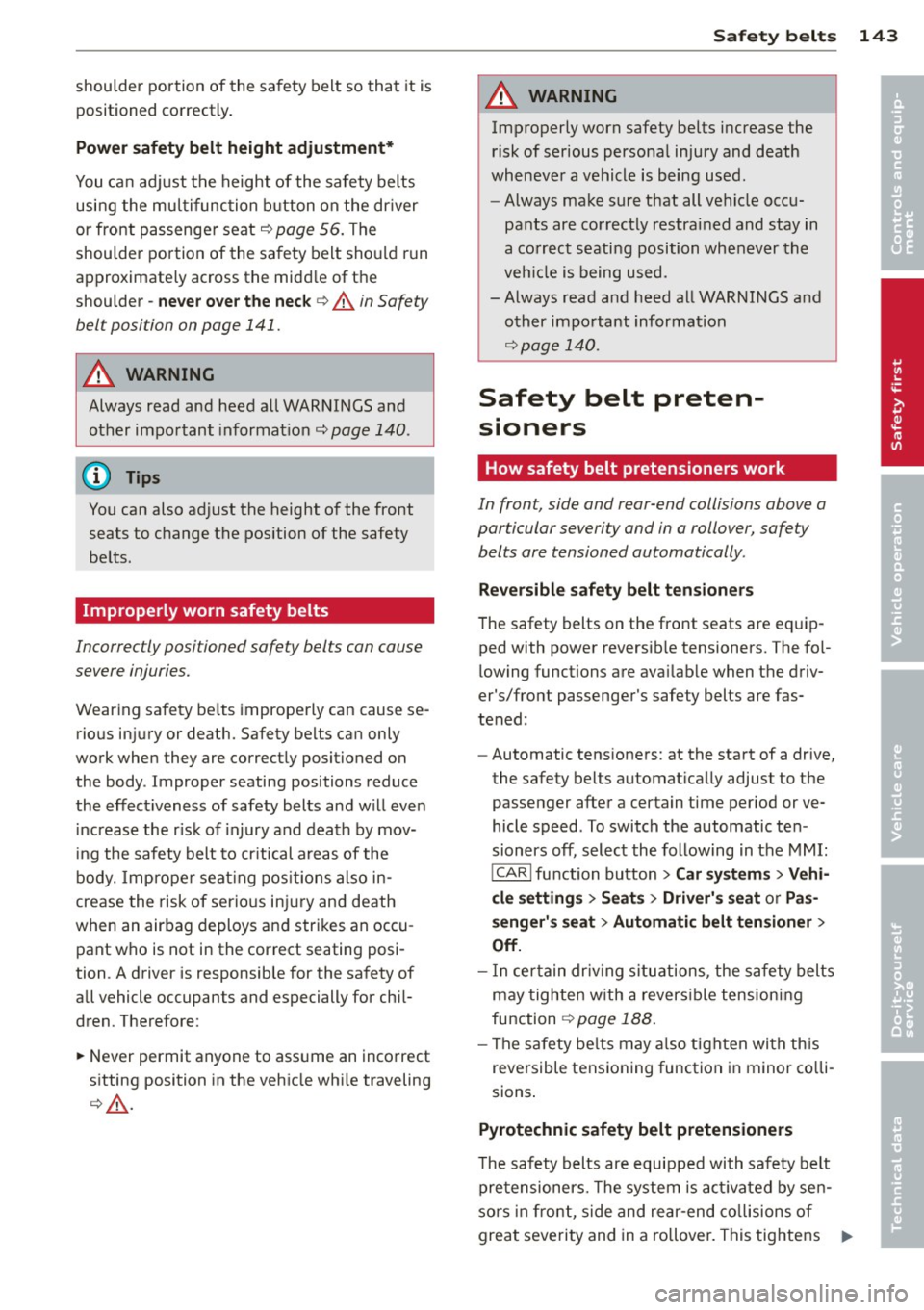
shoulder portion of the safety belt so that it is
positioned correctly .
Power safety belt h eight adju stment*
You ca n adjust the height of the safety belts
usi ng the multifunc tion b utton on the dr iver
or front passenger seat
c> page 56. The
shoulder portion of the sa fety belt sho uld r un
approximately across the midd le of the
shoulder -
never o ver the nec k c> A in Safety
bel t posi tion on page 141.
A WARNING
Always read and heed all WARNINGS and
other impo rtant informat io n
c> page 140 .
(D Tips
You can also ad just the height of the front
seats to c hange the position of the safety
be lts.
Improperly worn safety belts
Incorrectly posi tioned safety belts con cause
severe injuries.
Wearing safety be lts imprope rly can cause se
rio us injury or death. Safety belts can only
work when they are correct ly positioned on
the body . Improper seating positions reduce
the effect iveness of safety belts and w ill eve n
in crease the r isk of injury and death by mov
in g the safety belt to cr itical a reas of the
body. Imp roper seat ing pos it ions also in
crease the risk of serio us inj ury and de ath
when an airbag deploys a nd strikes an occu
pant who is not in the correct seating posi
tion . A driver is responsib le for the safety of
all vehicle occupants and especially for chi l
dren. Therefore :
~ Never permit anyone to ass ume an inco rrect
s itting position in the veh icle wh ile traveling
c> .,&. .
Sa fety belts 143
A WARNING
Improperly worn safety belts increase the
risk of serious persona l injury and death
whenever a vehicle is being used.
- Always make sure that all vehicle occu-
pants are correc tly restrained and stay in
a co rrect seating position whenever the
veh icle is being used .
- Always read a nd heed all WAR NINGS a nd
other important information
c> poge 140.
Safety belt preten
sioners
How safety belt pretensioners work
In front, side and rear-end collisions above a
particular severi ty and in a rollover, safe ty
belts ore tensioned automatically .
Reve rsible safety belt ten sione rs
The safety belts on the front seats are equip
ped with power reversib le tensioners . The fo l
lowing functions are ava ilab le when the driv
er 's/fro nt passenge r's safety belts are fas
tened :
- Automatic tens ioners: at the start of a drive,
the safety belts automat ica lly adjus t to the
passenger after a certain time period or ve
hicle speed . To switch the automatic ten
sioners off, select the following in the
MMI :
!CARI function button > Car sy ste m s> Vehi
cle settings > Seat s> Driv er's seat or P as
s eng er' s s eat
> Automati c belt ten sioner >
Off.
- I n cer tain dr iv ing s itu ations , the safety belts
may tighten w ith a revers ible tens ion ing
function
c> poge 188.
-The safety be lts may also t ighten wi th th is
reve rsible tensioning function in minor co lli
sions .
Pyrotechnic safety belt pretensioners
The safety belts are equipped with safety belt
p re tensioners. The system is ac tiva ted by sen
sors in fro nt, side and rear -end co llisions of
great severity and in a rollover. This tig htens
1J1>
•
•
Page 146 of 302
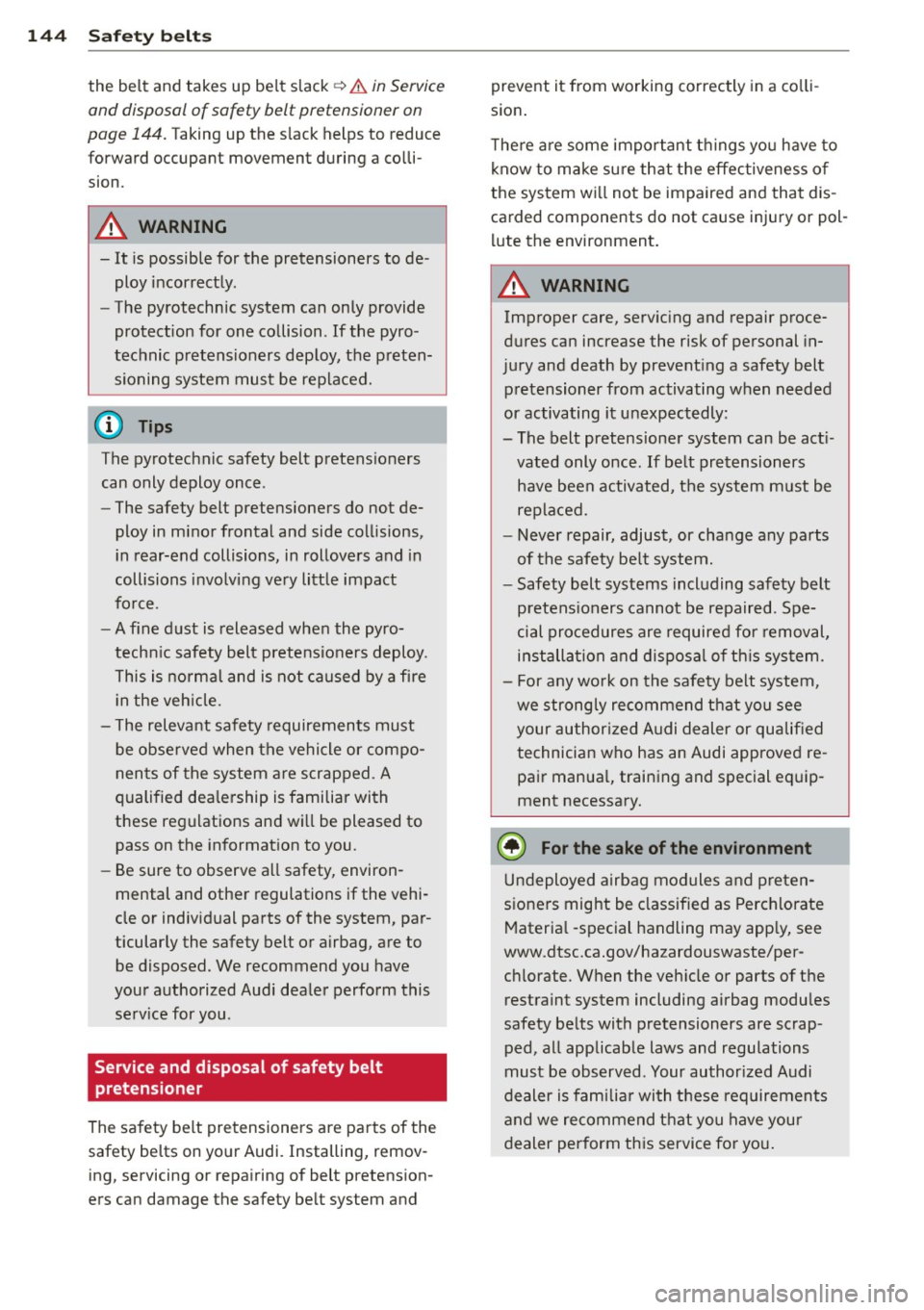
144 Safety belts
the belt and takes up belt slack c> .& in Service
and disposal of safety belt pretensioner on
pag e
144. Taking up the slack helps to reduce
forward occupant movement during a colli
sion.
_& WARNING
- It is possible for the pretensioners to de
ploy incorrectly .
- The pyrotechnic system can only provide
protection for one collision . If the pyro
technic pretensioners deploy, the preten sioning system must be replaced.
(D Tips
The pyrotechnic safety belt pretensioners can only deploy once .
- The safety belt pretensioners do not de
ploy in minor frontal and side collisions,
in rear-end collisions, in rollovers and in
collisions involving very little impact
force .
-A fine dust is released when the pyro
technic safety belt pretensioners deploy .
This is normal and is not caused by a fire
in the vehicle.
- The relevant safety requirements must
be observed when the vehicle or compo
nents of the system are scrapped . A
qualified dealership is familiar with
these regulations and will be pleased to
pass on the information to you.
- Be sure to observe all safety, environ
mental and other regulations if the vehi
cle or individual parts of the system, par
ticularly the safety belt or airbag, are to be disposed . We recommend you have
your authorized Audi dealer perform this
service for you .
Service and disposal of safety belt
pretension er
The safety belt pretensioners are parts of the
safety belts on your Audi. Installing, remov
ing, servicing or repairing of belt pretension
ers can damage the safety belt system and prevent it from working correctly
in a colli
sion.
There are some important things you have to
know to make sure that the effectiveness of
the system will not be impaired and that dis
carded components do not cause injury or pol
lute the environment.
_& WARNING
Improper care, servicing and repair proce
dures can increase the risk of personal in
jury and death by preventing a safety belt
pretensioner from activating when needed
or activating it unexpectedly :
- The belt pretensioner system can be acti
vated only once . If belt pretensioners
have been activated, the system must be
replaced.
- Never repair, adjust, or change any parts
of the safety belt system.
- Safety belt systems including safety belt
pretensioners cannot be repaired. Spe
cial procedures are required for removal,
installation and disposal of this system.
-For any work on the safety belt system,
we strongly recommend that you see
your authorized Audi dealer or qualified
technician who has an Audi approved re
pair manual, training and special equip
ment necessary.
@ For the sake of the environment
Undeployed airbag modules and preten
sioners might be classified as Perchlorate
Material -special handling may apply, see
www .dtsc.ca.gov/hazardouswaste/per
chlorate. When the vehicle or parts of the restraint system including airbag modules
safety belts with pretensioners are scrap ped, all applicable laws and regulations
must be observed . Your authorized Audi
dealer is familiar with these requirements
and we recommend that you have your
dealer perform this service for you.
Page 147 of 302
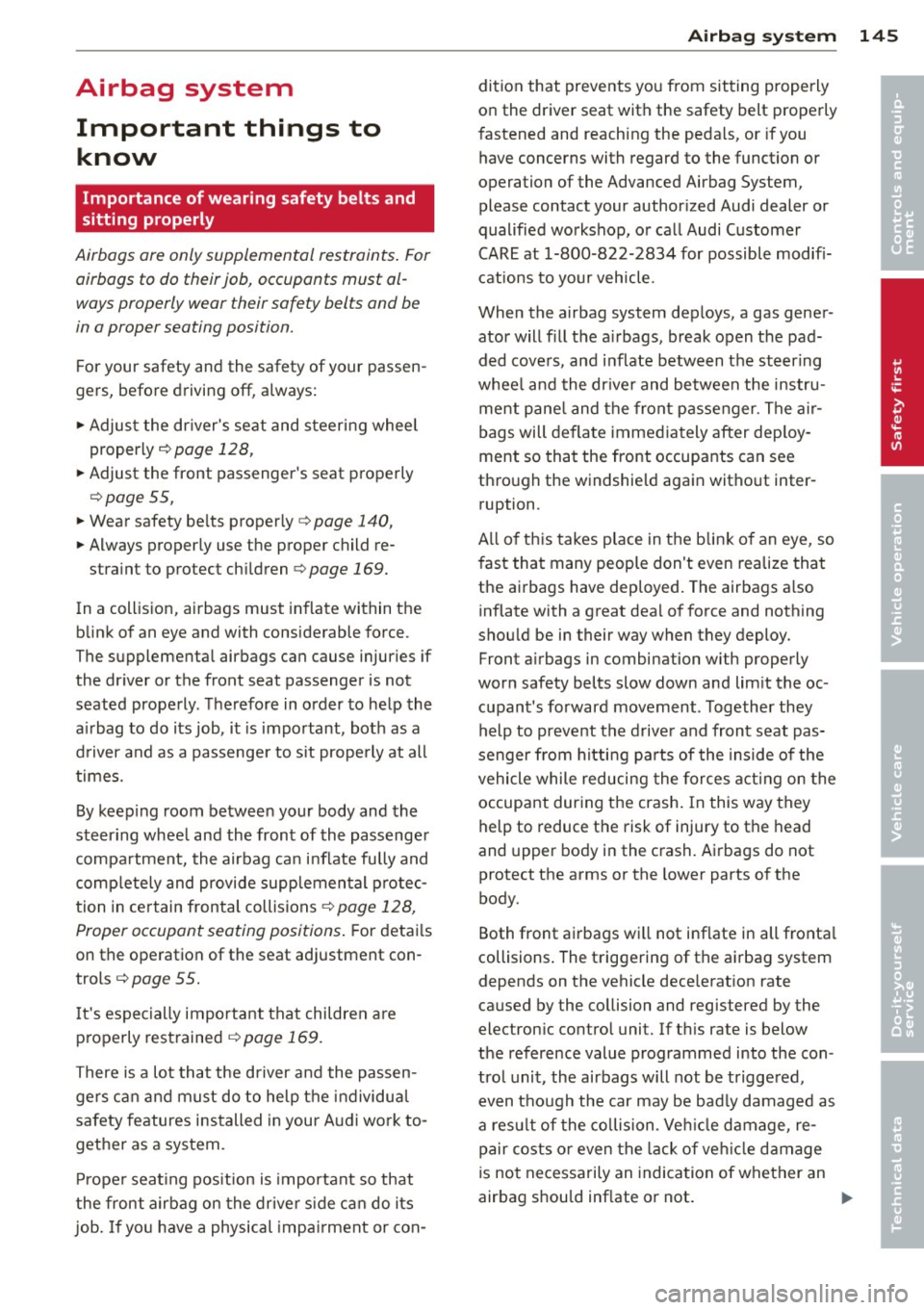
Airbag system Important things to know
Importance of wearing safety belts and
sitting properly
Airbags are only supplemental restraints. For
airbags to do their job , occupants must al
ways properly wear their safety belts and be
in a proper seating position.
For your safety and the safety of your passen
gers, before driving off, always:
"" Adjust the driver's seat and steering wheel
properly ¢
page 128,
"" Adjust the front passenger's seat properly
¢page 55,
""Wear safety be lts properly ¢ page 140,
""Always properly use the proper child re-
straint to protect chi ldren
r::::> page 169.
In a collision, airbags must inflate within the
blink of an eye and with considerable force.
The supplemental airbags can cause injuries if
the driver or the front seat passenger is not
seated properly . Therefore in order to help the
a ir bag to do its job, it is important, both as a
driver and as a passenge r to s it properly at all
times.
By keeping room between your body and the
steer ing wheel and the front of the passenger
compartment, the airbag can inflate fully and
comp letely and provide supplemental protec
tion in certain frontal collisions
r::::> page 128,
Proper occupant seating positions.
F or details
on the operation of the seat adjustment con
trols ¢
page 55.
It's especially important that children a re
properly restrained
r::::> page 169.
There is a lot that the driver and the passen
gers can and must do to help the individual
safety features installed in your Aud i work to
gether as a system.
Proper seating pos ition is important so that
the front airbag on the driver side can do its
job. If you have a physical impairment or con-
Airbag system 145
dition that prevents you from sitting properly
on the driver seat with the safety belt properly
fastened and reaching the pedals, or if you
have concerns with regard to the function or
operation of the Advanced Airbag System,
please contact your author ized Audi dealer or
qualified workshop, or call Audi Customer
CARE at 1-800-822-2834 for possible modifi
cations to your vehicle .
When the airbag system dep loys , a gas gener
ator will fill the a irbags, break open the pad
ded covers, and inflate between the steer ing
whee l and the driver and between the instru
ment panel and the front passenger. The air
bags will deflate immediately after deploy
ment so that the front occupants can see
through the windshield again without inter ruption.
A ll of th is takes place in the blink of an eye, so
fast that many people don't even realize that
the airbags have deployed. The airbags a lso
inflate with a great dea l of force and nothing
shou ld be in their way when they deploy.
Front airbags in combination with properly
worn safety belts slow down and lim it the oc
cupant's forward movement. Together they
help to prevent the driver and front seat pas
senger from hitting parts of the inside of the
vehicle while reducing the forces acting on the
occupant during the crash. In this way they
help to reduce the risk of injury to the head
and upper body in the crash. Airbags do not
protect the arms or the lower parts of the
body.
Both front airbags will not inf late in all fronta l
collisions . The triggering of the airbag system
depends on the vehicle dece lerat ion rate
caused by the collision and registered by the
electron ic control unit. If th is rate is below
the reference value programmed into the con
trol unit, the airbags will not be trigge red,
even though the car may be bad ly damaged as
a result of the collision . Vehicle damage, re
pair costs or even the lack of ve hicle damage
is not necessarily an indication of whether an
airbag should inf late or not . •
•
Page 148 of 302
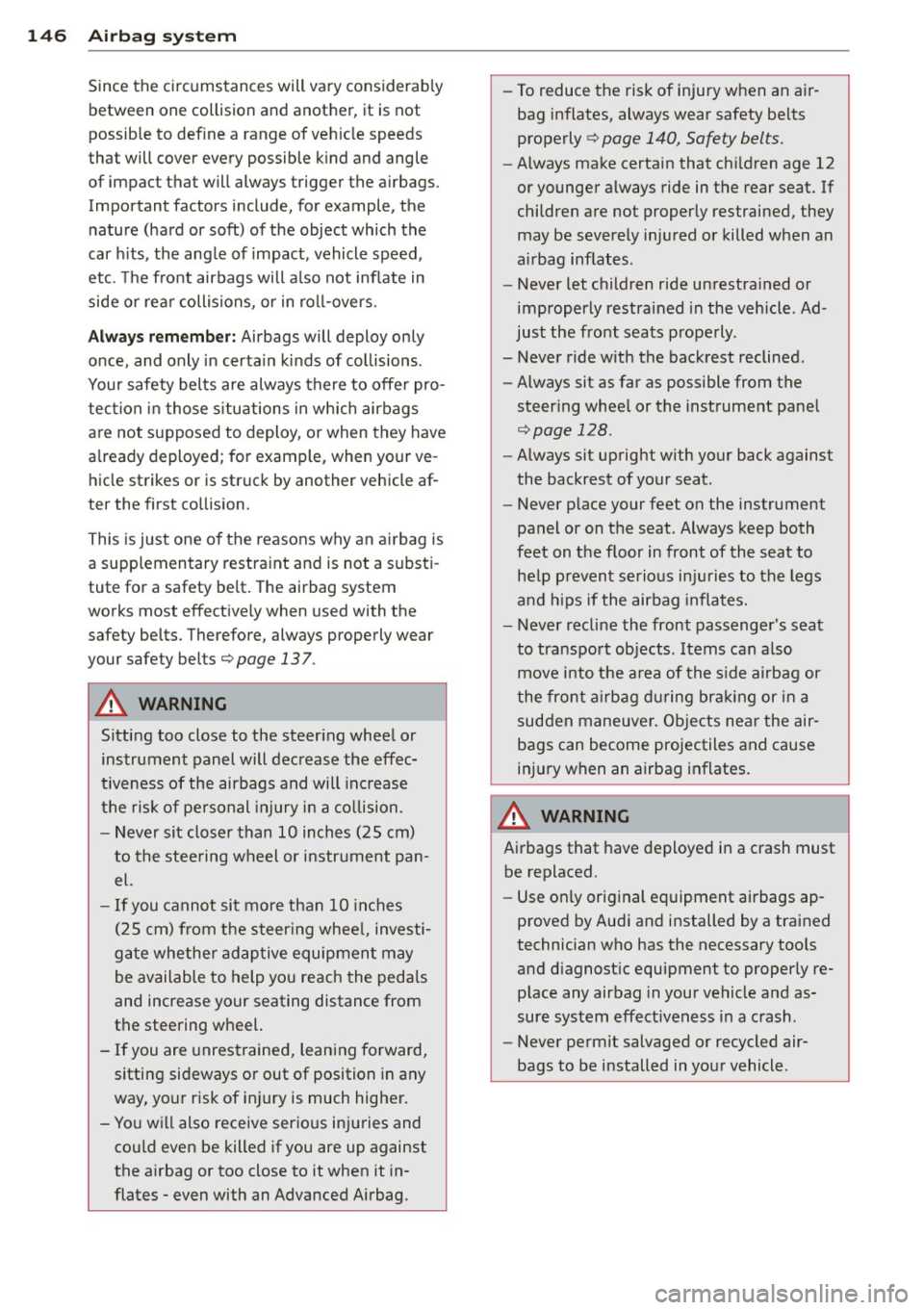
146 Airbag sys te m
Since the cir cumstances will vary considerab ly
between one collision and anot her, it is not
possib le to def ine a range of vehicle speeds
that will cover every possible k ind and angle
of impact that will always trigger the airbags.
Important factors include, for example, the
nature (hard or soft) of the object which the
car h its, the ang le of impact, vehicle speed,
etc. The front airbags will also not inflate in
side or rea r collisions, or in ro ll-overs .
Always remember : Airbags will deploy only
once, and only in certa in kinds of co llisions.
Your safety belts are always there to offer pro
tection in those s ituations in which airbags
are not supposed to deploy, or when they have
a lready deployed; for example, when your ve
hicle strikes or is struck by another vehic le af
ter the first co llision.
This is just one of the reasons why an airbag is
a supplementary restraint and is not a substi
tute for a safety belt . The airbag system
works most effect ively when used with the
safety belts. Therefore, always properly wear
your safety belts
c::;, page 137.
A WARNING
Sitting too close to the steer ing wheel or
instrument panel will dec rease the effec
t iveness of the airbags and will increase
the risk of personal injury in a collision .
- Never sit closer than 10 inches (2S cm)
to the stee ring wheel or instrument pan
el.
- If you cannot sit more than 10 inches
( 2 5 cm) from the s teer ing whee l, investi
gate whethe r adaptive equipmen t may
be available to help you reach the pedals
and increase your seating distance from
the steering wheel.
- If you are unrestrained, lean ing fo rward,
sitting sideways or out of position in any
way, your risk of in jury is much higher.
- You will also receive serio us injuries and
cou ld even be killed if you are up against
the airbag or too close to it when it in
flates - even with an Advanced Airbag. -
To reduce the risk of injury when an a ir
bag inflates, always wear safety be lts
properly
c::;, page 140, Safety belts.
- Always make certain that ch ildren age 12
or younger always ride in the rear seat. If
children are not properly restrained, they
may be severely injured or killed when an
airbag inflates.
- Never let children ride unrestrained or
improperly restrained in the vehicle. Ad
just the front seats prope rly .
- Never ride with the backrest reclined.
- Always sit as far as possible from the
steer ing whee l or the instrument pane l
c::;, page 128.
-Always sit upright with your back against
the backrest of your seat .
- Never p lace your feet on the instrument
panel or on the seat. Always keep both
feet on the floor in front of the seat to
help prevent serio us in ju ries to the legs
and h ips if the airbag inflates.
- Never recline the front passenger 's seat
to transpor t objects , Items can a lso
move into the a rea of the s ide airbag or
the front a irbag du ring bra king or in a
sudden maneuve r. Objects nea r the air
bags can become projectiles and cause
in jur y when an airbag inflates.
A WARNING ~
Airbags that have deployed in a crash must
be replaced.
- Use on ly orig inal equipment airbags ap
proved by Aud i and installed by a trained
technician who has the necessary too ls
and d iagnost ic equipment to properly re
p lace any airbag in your vehicle and as
sure system effectiveness in a crash .
- Never permit salvaged or recycled air
bags to be installed in your vehicle.
Page 149 of 302
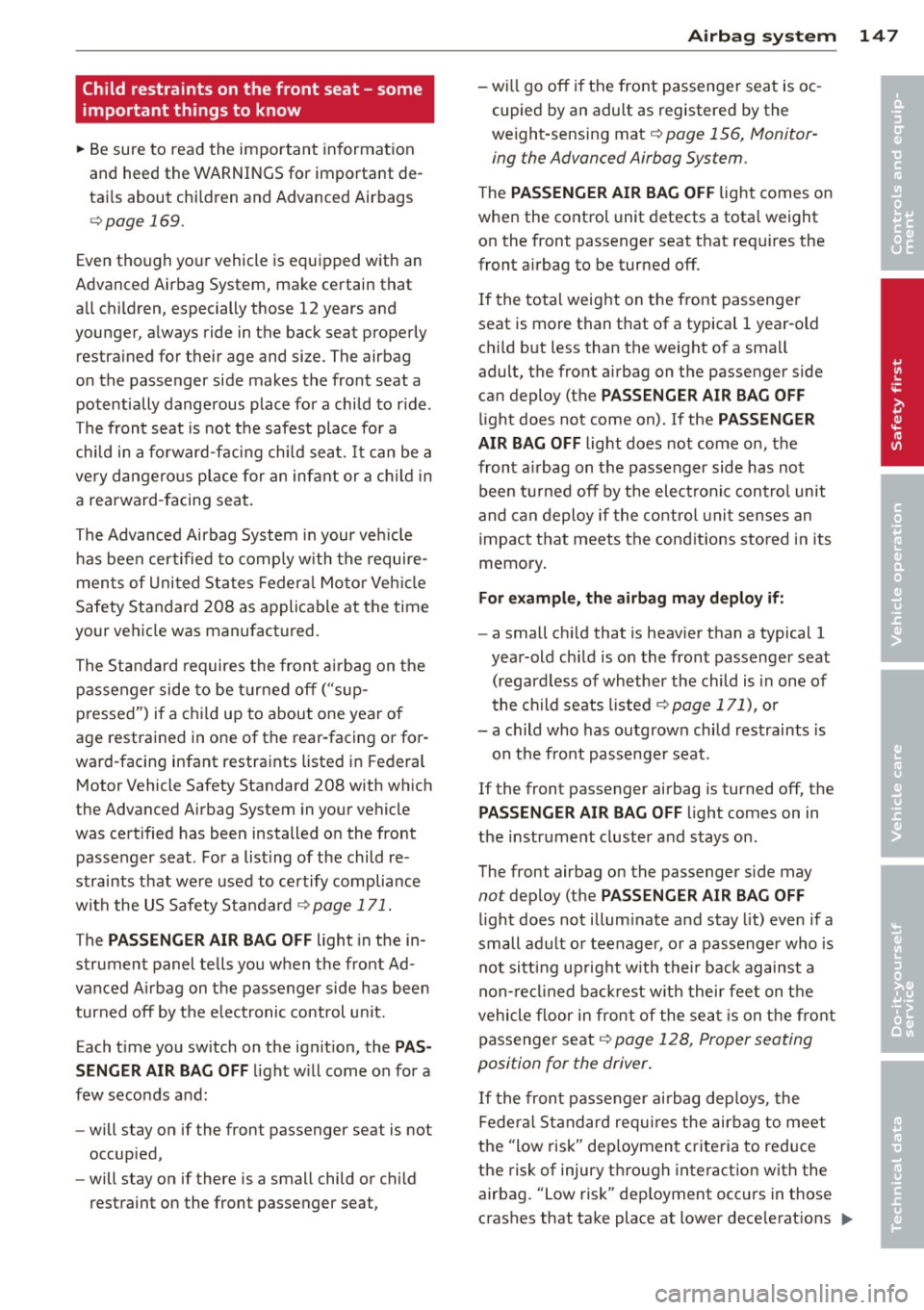
Child restraints on the front seat - some
important things to know
.. Be sure to read the important informat ion
and heed the WARNINGS for important de
tai ls about chi ldren and Advanced Airbags
~ page 169.
Even though your vehicle is equipped with an
Advanced Airbag System, make certain that
a ll chi ldren, especially those 12 years and
younger, always ride in the back seat properly restra ined for their age and si ze. The airbag
on the passenger side makes the front seat a potentially dangerous place for a child to r ide .
The front seat is not the safest place fo r a
chi ld in a fo rward-facing chi ld seat. It can be a
very dange ro us p lace for an infant or a ch ild in
a rearward -facing seat.
The Advanced Airbag System i n your veh icle
h as been cert ified to comp ly with the require
men ts of Uni ted States Federa l Mo to r Veh icle
Safety Standard 208 as applicable at the time
your vehicle was manufactured.
The Standard requires the front a irbag on the
passenger side to be turne d off ("sup
p ressed") if a chi ld up to about one year of
age restrained in one of the rear -facing or for
ward -facing infant restraints listed i n Federal
Motor Vehicle Safety Standard 208 with wh ich
the Advanced Airbag System in your vehicle
was certified has been installed o n the front
passenger seat . For a listing of the child re
straints that we re used to certify compliance
with the US Safety Standard ~
page 171.
The PASSENGER AIR BAG OFF light in the in
strument panel te lls you when the front Ad
vanced A irbag on the passenger side has been
turned off by the e lectronic control u nit.
Each t ime you sw itch on the ignit ion, the
PAS
SENGER AIR BAG OFF
l ight w ill come on for a
few seconds a nd:
- will stay on if the front passenger seat is not
occup ied ,
- will stay on if there is a small child or child
restraint on the front passenger seat,
A irbag sys tem 147
- will go off if the front passenger seat is oc
cupied by an adult as registered by the
weight -sensing mat ¢
page 156, Monitor
ing the Advanced Airbag System.
T he PASSENGER AIR BAG OFF light comes on
whe n the contro l unit detects a tota l weight
on the front passenger seat that req uires the
front a irbag to be turned off.
If the total weight on the front passenger
seat is more than that of a typical 1 year-old
c h il d but less than the weight of a small
adult, the front airbag on the passenger side can deploy (the
PASSENGER AIR BAG OFF
li ght does not come on). If the PASSENGER
AIR BAG OFF
light does not come on, the
front a irbag on the passenger side has not
been turned off by the elect roni c con trol unit
and can deploy if the control unit se nses an
impact that meets the cond it ions stored i n its
memory .
For example, th e airb ag may deplo y if:
- a small ch ild that is heav ie r than a typical 1
year-old ch ild is o n the front passenger seat
(regard less of whether the child is in one of
the ch ild seats l isted
¢ page 171), or
- a child who has outgrown child restraints is
on the front passenge r seat.
If the front passenger airbag is turned off, the
PASSENGER AIR BAG OFF light comes on in
the instr ument cluster and stays on .
The front airbag on the passenger side may
not deploy (the PASSENGER AIR BAG OFF
l ight does not illum inate and stay lit) even if a
small ad ult o r teenager, or a passenger who is
not sitti ng uprig ht w ith their back against a
non -recli ned back rest w it h thei r feet on the
vehicle floor in front of the sea t is on t he front
passenger seat~
page 128, Proper seating
position for the driver.
If t he fron t passenger ai rbag dep loys, the
Federa l Standard requ ires the airbag to meet
the "low risk" dep loyment criteria to reduce
the ris k of injury t hro ugh inte ract ion w ith the
airbag. "Low risk" dep loyment occ urs in those
crashes that take place at lowe r dece lerat ions .,.. •
•
Page 150 of 302
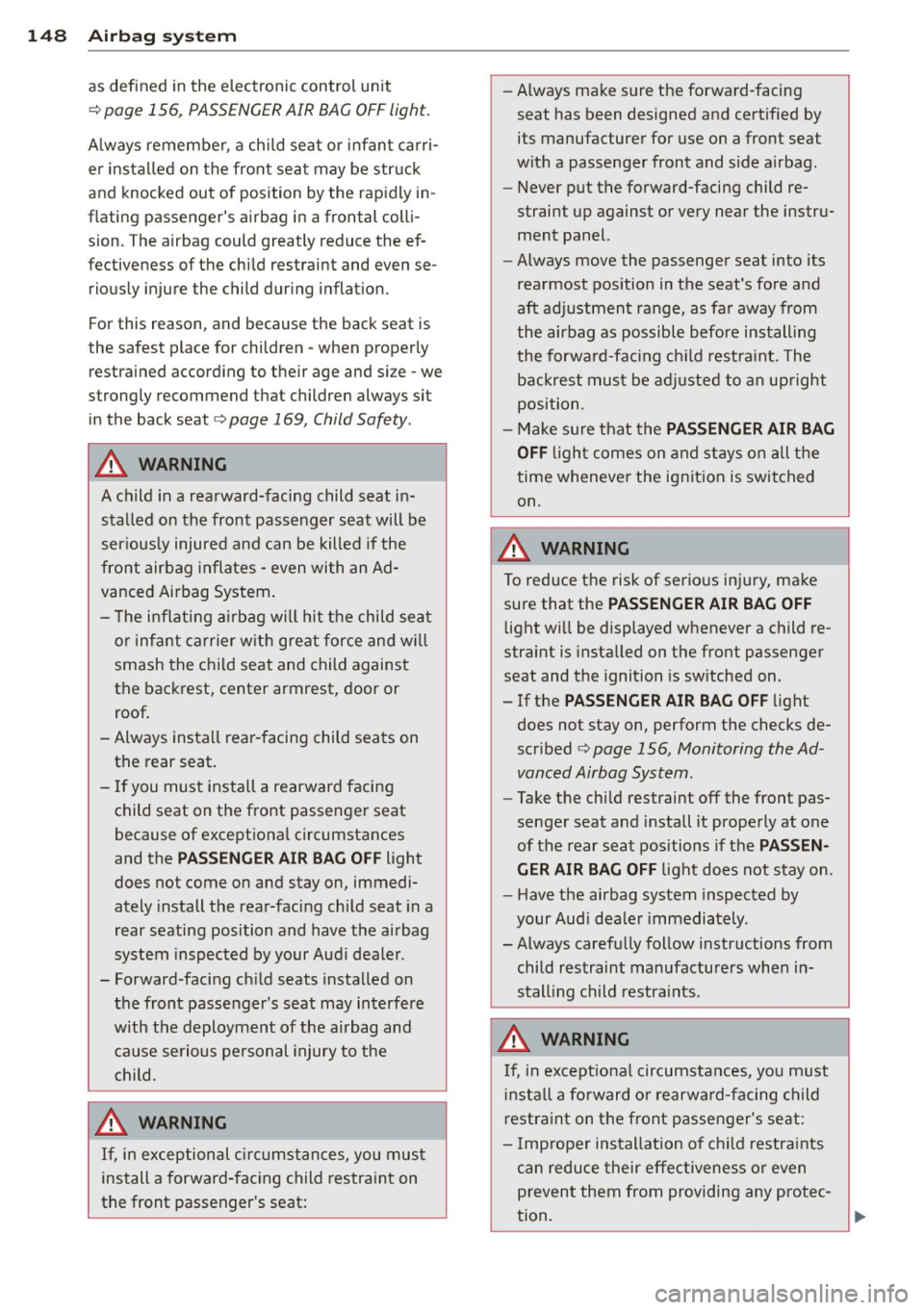
148 Airbag sys tem
as def ined in the electronic control unit
Q page 156, PASSENGER AIR BAG OFF light.
A lways remember, a ch ild sea t or infan t carr i
e r i nsta lled on the front sea t may be struck
and knocked out of position by the rapidly in
flating passenger's airbag in a frontal colli
sion. The airbag could greatly reduce the ef
fectiveness of the chi ld restraint and even se
rious ly injure the child during inflat ion.
F or this reason, and because the back seat is
the safest p lace for chi ldren -when p roperly
restra ined accord ing to their age and si ze -we
strongly recommend that children always sit
in the back seat
Q page 169, Child Safety .
A WARNING
A child in a rearward-facing child seat in
stalled on the front passenger s eat will be
ser iously injured and can be killed if the
front airbag inflates -even with an Ad
vanced Airbag System.
- The inflating a irbag will hit the child seat
or inf ant carrier w ith great force and w ill
smash the ch ild seat and child agains t
the backrest, center armrest, door or
roof .
- Always install rear -facing child sea ts on
the rear seat .
- If you mus t install a rearward facing
child seat on the f ront passenge r seat
because of except iona l circumstances
and the
PASSENGER AIR BAG OFF light
does not come on and stay on, immedi
ately i nstall the rear-facing chi ld seat in a
rear seating position and have the airbag
system inspected by your Aud i dealer .
- Forward-fac ing ch ild seats installed on
the front passenger's seat may in terfere
with the deployme nt of the airbag and
c ause se rious pe rsonal injury to the
ch ild.
A WARNING
If, in exception al c ircumstances, you mus t
install a forwa rd-facing child restra int on
the front passenger's seat: -
Always make sure the forward-facing
seat has been designed and certified by
its manufacturer for use on a front seat
with a passenger front and s ide a irbag .
- Never put the forward-facing child re
straint up against or very near the instru ment panel.
- Always move the passenger seat into its
rearmost pos ition in the seat's fore a nd
aft ad justment range, as fa r away from
the airbag as possible b efore installing
the forwa rd-fa cing ch ild restra int. The
b ackrest mus t be a djusted to a n up right
position.
- Make sure that the
PASSENGER AIR BAG
OFF
li ght comes on and st ays o n all the
time wheneve r the ignition is swi tched
on.
A WARNING -ra-----
To reduce the risk of serious injury, make
sure that the
PASSENGER AIR BAG OFF
light will be displayed whenever a child re
straint is installed on the front passenger
seat and the ignition is sw itched on.
- If the
PASSENGER AIR BAG OFF light
does not stay on, perform the checks de
scribed
Q page 156, Monitoring the Ad
vanced Airbag System .
-Take t he chi ld restraint off the front pas
senger seat and install it prope rly at one
of the rear seat positions if the
PASSEN
GER AIR BAG OFF
light does not stay on.
- Have the airbag system inspected by
your Aud i dea le r i mmediately .
- Always carefully follow instr uctions from
child restraint manufacture rs when in
stall ing c hild restra ints .
A WARNING
If, in except iona l circumsta nces, you m ust
i nstall a forward or rearwa rd-fa cing child
r estra int on the front p assenger's se at:
- I mp roper ins tallatio n of ch ild restra ints
c a n reduce their effectiveness or even
p revent them from providing any protec -
tion. .,..